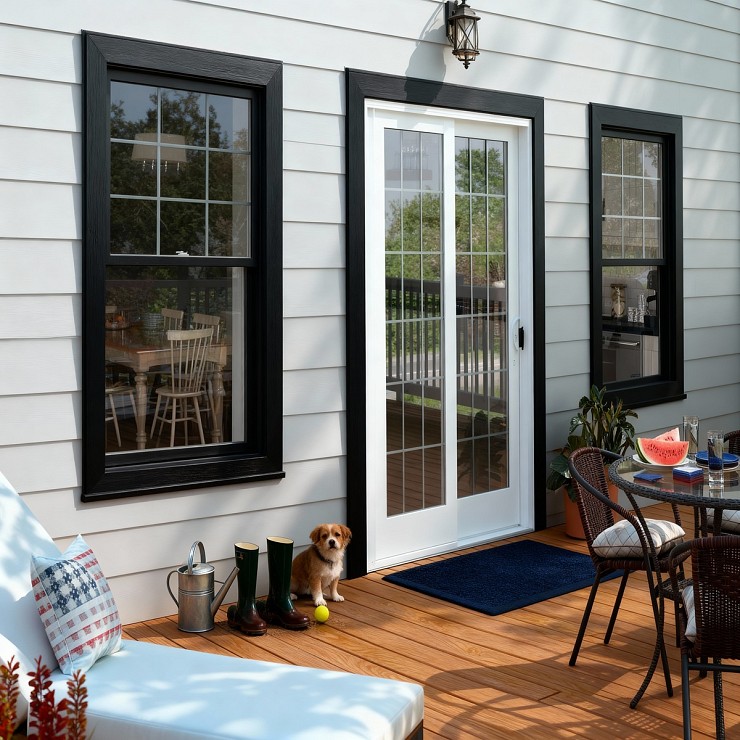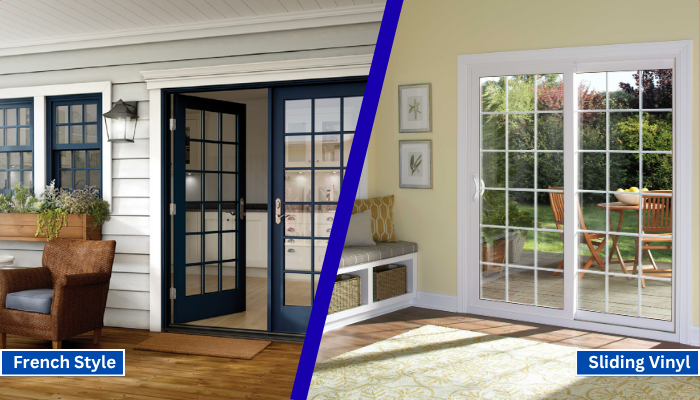Vinyl Patio Doors: Air/Water Infiltration, Installation Tips & Maintenance (Toronto)

Thinking of installing vinyl patio doors in your Toronto home? Or maybe you already have them, but something feels off?
You're not alone.
Vinyl patio doors are popular here for good reasons. They’re durable, energy-efficient, and look great. But like anything in your home, they need proper installation and care.
One of the biggest issues? Air and water infiltration.
If your door isn’t sealed properly, Toronto’s freezing winters or rainy springs will find their way in. And that can mean drafts, higher heating bills, or worse; water damage.
Let’s walk through what vinyl patio doors are, how infiltration happens, and what you can do to keep your home protected.
What Are Vinyl Patio Doors?
Vinyl patio doors are sliding or swinging doors made from polyvinyl chloride: PVC.
The material is lightweight but tough. It doesn’t rot, rust, or peel like wood or metal. That’s why it’s a top choice for homeowners in Toronto, especially with our changing seasons.
There are mainly two types:
Sliding vinyl patio doors
French-style or swinging vinyl doors
Both can include double or triple-pane glass, Low-E coatings, and insulated frames.

Why choose vinyl?
It’s cost-effective
Easy to maintain
Good insulator
Long lifespan with proper care
It’s also customizable. You’ll find vinyl patio doors in different colors, sizes, and designs to match your space.
Air and Water Infiltration: Why It’s a Big Deal
Let’s start with air infiltration.
If cold air slips in around the doorframe, your heating system works harder. That means higher energy bills. Even worse, you may feel uncomfortable sitting near the door during winter.
Now, about water infiltration.
This happens when rainwater seeps through gaps or cracks. It may look like a small leak at first, but over time, it can cause:
Mold buildup
Damaged flooring
Swollen door frames
Rot in wooden substructures
Toronto homes are especially at risk because of our wet springs and freeze-thaw cycles. Water can sneak in, freeze, expand, and make gaps even wider.
Some numbers to give you context:
A study by Natural Resources Canada found that air leakage around doors and windows accounts for up to 25 percent of heat loss in older homes
Even new builds can suffer if patio doors aren’t installed or sealed properly
In short, infiltration hurts your comfort and your wallet. But the good news? It's preventable.
Choosing the Right Vinyl Patio Door in Toronto
Not all vinyl patio doors are made the same.
In Toronto, you need a door that can handle extreme cold, wind, and heavy rain. So when you're shopping, focus on performance: not just looks.
Here’s what to check:
1. Energy Efficiency
Look for the ENERGY STAR® Canada label. That means the door meets strict energy performance standards.
Check the U-Factor. Lower is better. It tells you how well the door keeps heat inside.
Also look at the Solar Heat Gain Coefficient (SHGC). This tells you how much sunlight the door lets in as heat. In colder months, a higher SHGC helps you stay warm. But if your room gets a lot of sun, you might want a lower one.
2. Glass Type
Go for double or triple-pane glass with Low-E coating. These keep your home warm in winter and cool in summer.
Low-E (low emissivity) glass reflects heat back into your home. That means less energy loss.
3. Frame and Seals
Good vinyl doors come with insulated frames and strong weatherstripping. These are your first defense against drafts and leaks.
Make sure the door includes multi-chambered frames. They trap air for better insulation.
4. Check Local Building Codes
Toronto building codes require minimum insulation standards. Your door needs to meet these. If you're unsure, ask your installer.
Bottom line: choose a door made for Canadian winters. It’s worth it.
Installation Best Practices
Even the best vinyl patio door won’t work properly if it’s installed wrong.
In fact, most air or water problems come from poor installation: not the door itself.
Here’s what good installation looks like:
1. Hire a Certified Installer
This isn’t a DIY job. Get someone experienced: especially with doors in cold climates.
Ask for references. Make sure they’ve worked in Toronto and understand the local conditions.
2. Proper Flashing and Waterproofing
Flashings are thin layers that keep water out of joints and corners. Your installer should use them around the sill, jambs, and head of the frame.
They also need to apply waterproof membranes or sealant tapes. This keeps rain from getting behind the frame.
3. Use a Sill Pan
A sill pan is a waterproof tray under the door. It catches water and drains it outside.
If your installer skips this step, you could end up with hidden water damage under your floor.
4. Leveling and Shimming
The door frame must sit level and square. Shims are small wedges that help align it perfectly.
A crooked frame causes gaps, hard sliding, and broken seals.
5. Sealing and Caulking
Once the frame is in, all gaps must be sealed with high-quality caulk. Not just outside; inside too.
Use low-expansion foam between the frame and wall to stop drafts without pushing the frame out of shape.
Done right, your door should glide smoothly, seal tight, and protect your home from Toronto’s harsh weather.
Signs of Air or Water Infiltration
Not sure if your patio door has a problem? Look closely. Small signs can point to big issues.
Here’s what to watch for:
Drafts or Cold Spots
Stand near the door on a cold day. If you feel a chill or notice your curtains moving slightly, air is leaking in.
This is one of the most common signs of poor sealing.
Fog Between the Glass
Double or triple-pane glass has gas sealed between the layers. If you see fog or moisture inside the panes, the seal is broken.
That means less insulation and more energy loss.
Water Stains or Soft Flooring
Check the floor near your door. If it feels soft, discolored, or warped, water may be getting in during rainstorms.
Also check the baseboards and the bottom of the wall.
Mold or Musty Smell
Water leaks encourage mold. Even if you don’t see it, a musty odor near the door could mean hidden moisture inside the wall.
Sticky or Hard-to-Open Door
Water damage or frame shifting can make the door swell or go out of alignment. If it suddenly becomes hard to slide, something may be wrong behind the scenes.
Spotting these early can save you from costly repairs. So check regularly, especially after a storm or snowmelt.
Repair vs Replacement
Sometimes a simple fix works. Other times, it’s time for a new door.
Let’s break it down:
When to Repair:
The issue is minor (like replacing a seal or latch)
Glass fogs, but the frame is in great shape
The door sticks, but it can be realigned
Caulking or weatherstripping is worn
Repairs usually cost less than $300 depending on the problem.
When to Replace:
The frame is warped or damaged
There’s repeated water damage
You feel strong drafts even after sealing
The glass is cracked or shattered
Your door is over 20 years old and inefficient
In Toronto, a quality vinyl patio door replacement can cost between $1,800 to $3,500 including installation. It depends on size, style, and energy features.
If your energy bills keep rising or you’re dealing with leaks year after year, replacement often makes more sense.
Cost Overview (Toronto on Based)
Let’s talk numbers.
Vinyl patio doors are affordable—but quality and proper installation still matter.
Average Cost
In Toronto, here’s what you can expect:
Basic vinyl sliding door (no upgrades): $1,500 to $2,200
Mid-range with energy-efficient glass: $2,000 to $2,800
Premium triple-pane or French-style vinyl doors: $2,800 to $4,000+
These prices usually include both the door and professional installation.
If your project needs extra waterproofing, wall repair, or custom sizing, costs can go higher.
Installation Only
Already have a door? Installation alone may cost $600 to $1,000, depending on the complexity.
Rebates or Incentives
You may qualify for government rebates.
For example, Enbridge’s Home Efficiency Rebate Plus (HER+) can help cover part of the cost if you're upgrading to ENERGY STAR-rated doors.
You’ll need a home energy assessment before and after the install. Check with a local energy advisor to see if you’re eligible.
Also, keep an eye on seasonal promotions from Toronto-based contractors. Some offer free installation or discounts during spring or fall.











